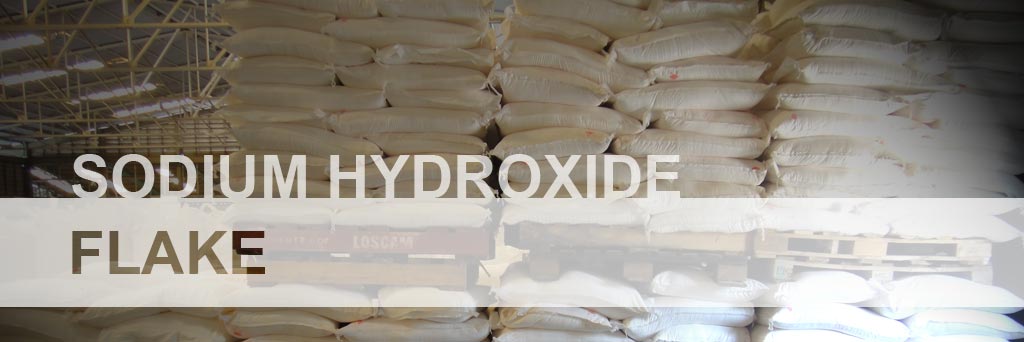| |
Sodium Hydroxide Flake (NaOH), also known as caustic soda flake and lye. It is used in many industries, mostly as a strong chemical base in the manufacture of pulp and paper, textiles, drinking water, soaps and detergents and as a drain cleaner.
Pure Sodium Hydroxide Flake is a white solid available in pellets, flakes, granules, and as a 50% saturated solution. It is hygroscopic and readily absorbs water from the air, so it should be stored in an airtight container. It is very soluble in water with liberation of heat. It also dissolves in ethanol and methanol, though it exhibits lower solubility in these solvents than does potassium hydroxide. Molten Sodium Hydroxide Flake is also a strong base, but the high temperature required limits applications. It is insoluble in ether and other non-polar solvents. A Sodium Hydroxide Flake solution will leave a yellow stain on fabric and paper.
Sodium Hydroxide Flake is the principal strong base used in the chemical industry. In bulk, it is most often handled as an aqueous solution, since solutions are cheaper and easier to handle. 56 % of Caustic Soda Flake produced is used by the chemical industry, with 25 % of the same total used by the paper industry. It is also used for the manufacture of sodium salts and detergents, for pH regulation, and for organic synthesis. It is used in the process of aluminium production.
For pH regulation uses, Sodium Hydroxide Flake is used in all sorts of scenarios where it is desirable to increase the alkalinity of a mixture, or to neutralize acids.
For paper making uses, it is a key component of the white liquor solution used to separate lignin from cellulose fibers in the Kraft process. It also plays a key role in several later stages of the process of bleaching the brown pulp resulting from the pulping process.
For tissue digestion uses, it is used to digest tissues, such as in a process that was used with farm animals at one time. This process involves the placing of a carcass into a sealed chamber, which then puts the carcass in a mixture of sodium hydroxide and water, which breaks chemical bonds keeping the body intact. This eventually turns the body into a coffee-like liquid, and the only solid that remains are bone hulls, which could be crushed between one's fingertips. It is frequently used in the process of decomposing roadkill dumped in landfills by animal disposal contractors. It has also been used by criminals to dispose of their victims' bodies.
For dissolving amphoteric metals and compounds uses, Sodium Hydroxide Flake reacts with aluminium and water to release hydrogen gas. The aluminium takes the oxygen atom from Caustic Soda Flake, which in turn takes the oxygen atom from the water, and releases the two hydrogen atoms. In this reaction, Caustic Soda acts as an agent to make the solution alkaline, which aluminium can dissolve in. This reaction can be useful in etching, removing anodizing, or converting a polished surface to a satin-like finish, but without further passivation such as anodizing or alodining the surface may become degraded, either under normal use or in severe atmospheric conditions.
For esterification and transesterification reagent uses, it is traditionally used in soap making (cold process soap, saponification). For the manufacture of biodiesel, it is used as a catalyst for the transesterification of methanol and triglycerides. This only works with anhydrous Sodium Hydroxide Flake, because combined with water the fat would turn into soap, which would be tainted with methanol. It is used more often than potassium hydroxide because it is cheaper and a smaller quantity is needed.
For cleaning uses, Sodium Hydroxide Flake is frequently used as an industrial cleaning agent. It is added to water, heated, and then used to clean the process equipment, storage tanks, etc. It can dissolve grease, oils, fats and protein based deposits. The solution can also be added surfactants to stabilize dissolved substances to prevent redeposition. A soak solution is used as a powerful degreaser on stainless and glass bakeware. It is also a common ingredient in oven cleaners.
For food preparation uses, it is used for washing or chemical peeling of fruits and vegetables, chocolate and cocoa processing, caramel coloring production, poultry scalding, soft drink processing, and thickening ice cream.
Sodium Hydroxide Flake may cause chemical burns, permanent injury or scarring if it contacts unprotected human, or other animal, tissue. It may cause blindness if it contacts with the eye. Protective equipment such as rubber gloves, safety clothing and eye protection should always be used when handling the material or its solutions.
Dissolution of Sodium Hydroxide Flake is highly exothermic, and the resulting heat may cause heat burns or ignite flammables. It also produces heat when reacted with acids. It is corrosive to some metals, e.g. aluminum, which produces flammable hydrogen gas on contact. It is also mildly corrosive to glass, which can cause damage to glazing or freezing of ground glass joints. |
|



